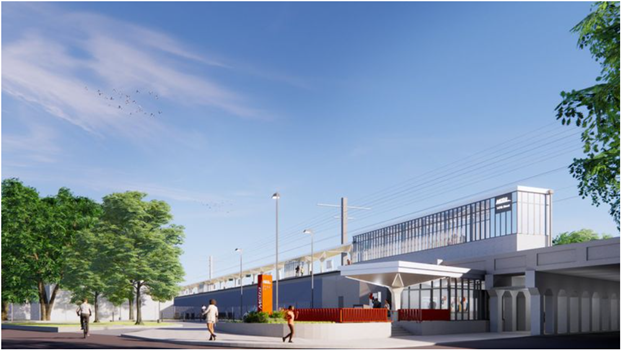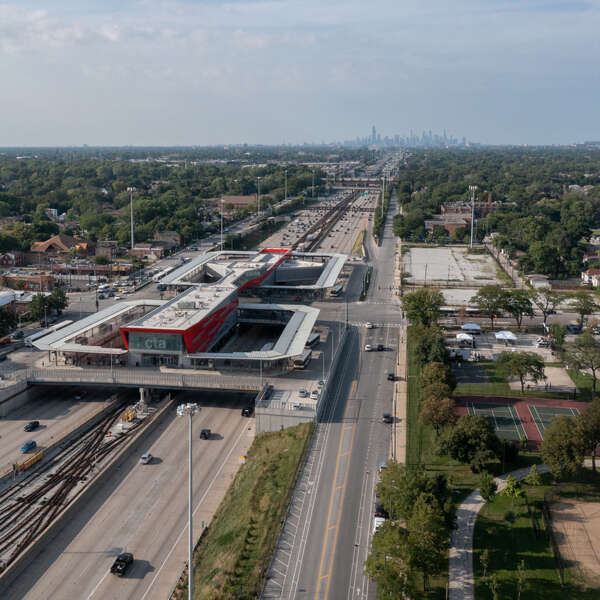Transit Oriented Development Plan moves Harvey toward a more vibrant, connected future
May 13, 2022
May 13, 2022

The recently adopted Harvey Transit Oriented Development (TOD) Plan envisions investment in the city’s transit infrastructure, improved connections for riders, and transformed public spaces, all of which will spur economic development for the southern Cook County suburb.
The Harvey TOD Plan was presented to the city council in March 2022 and completed with support from the RTA Community Planning program, which offers technical assistance and funding to local governments to address local planning needs where public transportation and land use intersect to connect people to the regional transit system.
The plan aims to build on Downtown Harvey’s role as a civic and public transit hub, generating over 3,400 bus and commuter rail trips a day from the Harvey Metra Station and adjacent Pace Bus transportation center – both of which are about to see significant investment.

 The Pace Pulse Program is also currently working to improve bus service along key corridors, including the Halsted Line. Improvements to bus service between the Harvey Transportation Center and 79th Street in Chicago are planned, including faster service with limited stops, new buses and shelters, real-time bus tracker information, and enhanced ADA-accessible bus platforms. Pace is also partnering with CTA to optimize bus service on the South Halsted Street Corridor, which will span from the CTA Red Line station at 79th Street to the Harvey Transportation Center. The project, called Pulse Halsted Line, will positively impact the 13,000 transit customers who use the corridor daily with improvements such as updated bus stations, dedicated-only bus lanes, and traffic signal optimization at key intersections.
The Pace Pulse Program is also currently working to improve bus service along key corridors, including the Halsted Line. Improvements to bus service between the Harvey Transportation Center and 79th Street in Chicago are planned, including faster service with limited stops, new buses and shelters, real-time bus tracker information, and enhanced ADA-accessible bus platforms. Pace is also partnering with CTA to optimize bus service on the South Halsted Street Corridor, which will span from the CTA Red Line station at 79th Street to the Harvey Transportation Center. The project, called Pulse Halsted Line, will positively impact the 13,000 transit customers who use the corridor daily with improvements such as updated bus stations, dedicated-only bus lanes, and traffic signal optimization at key intersections. 
Subscribe to our Newsletter
Related Articles
 New project management oversight report highlights more than 100 projects representing $8.2 billion in capital investments
New project management oversight report highlights more than 100 projects representing $8.2 billion in capital investments
The RTA’s Project Management Oversight (PMO) program ensures that the Service Boards—CTA, Metra, and Pace—are spending capital funds and managing their infra...
June 27, 2024 Transportation Tuesday recap: Improving and expanding the transit system strategically
Transportation Tuesday recap: Improving and expanding the transit system strategically
With last year’s adoption of Transit is the Answer came 15 new evaluation metrics that comprise a strategy for evaluating and selecting capital projects. Now...
May 30, 2024 Transit is the answer to meeting Illinois’ climate goals
Transit is the answer to meeting Illinois’ climate goals
As we celebrate Earth Day 2024, the RTA is announcing Transforming Transit —the agency’s commitment to lead the Chicago region’s transit system into the futu...
April 18, 2024 Three years into the Infrastructure Investment and Jobs Act, Chicago’s transit system is winning competitive grants and advancing critical projects
Three years into the Infrastructure Investment and Jobs Act, Chicago’s transit system is winning competitive grants and advancing critical projects
The Infrastructure Investment and Jobs Act (IIJA), passed in 2021, represented a historic level of federal investment for shoring up the nation’s infrastruct...
March 12, 2024 Why fully funding paratransit service and reduced fare programs is key to closing the transit budget gap
Why fully funding paratransit service and reduced fare programs is key to closing the transit budget gap
With transit facing a fiscal cliff in the coming years, fully funding critical programs like ADA paratransit service and free and reduced fare programs is on...
February 29, 2024 RTA releases semi-annual project management oversight report highlighting more than 100 capital projects
RTA releases semi-annual project management oversight report highlighting more than 100 capital projects
Under its Project Management Oversight (PMO) program, the RTA ensures that the Service Boards—CTA, Metra, and Pace—are spending capital funds and managing th...
January 3, 2024